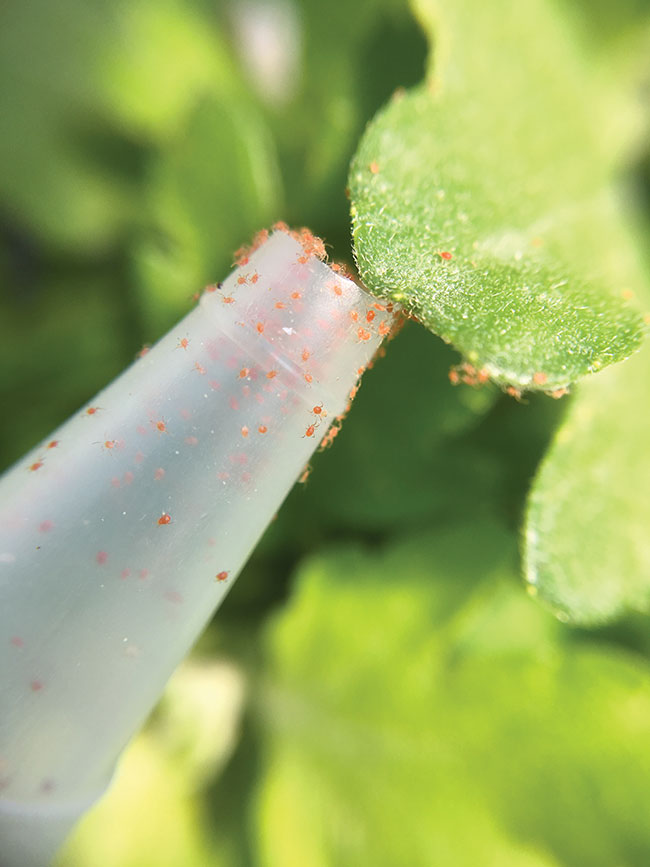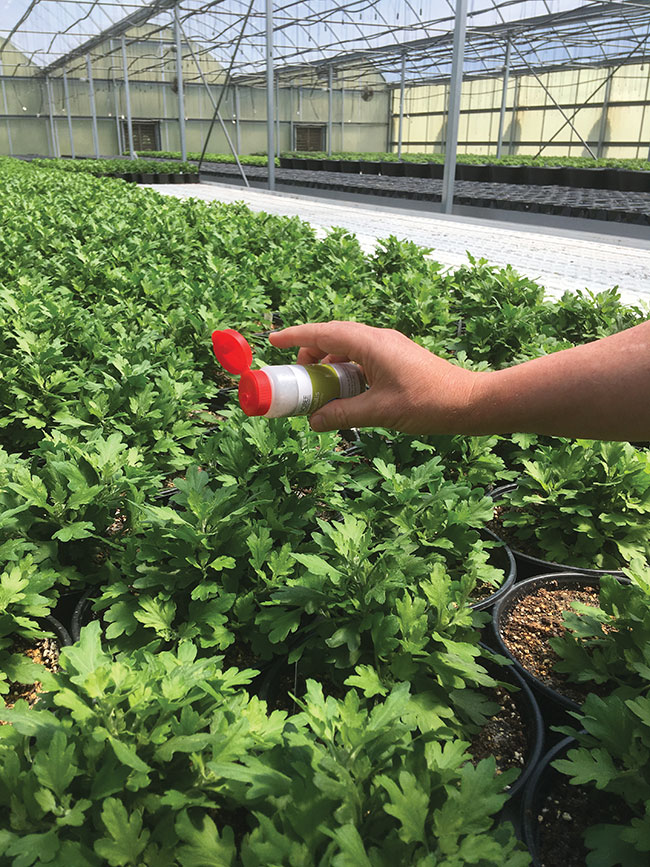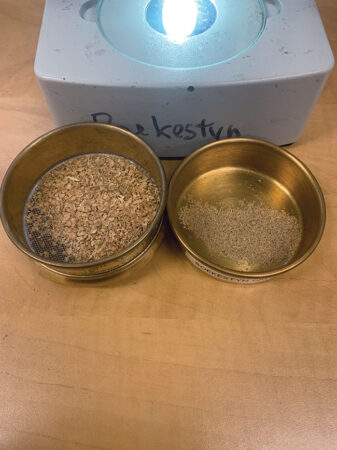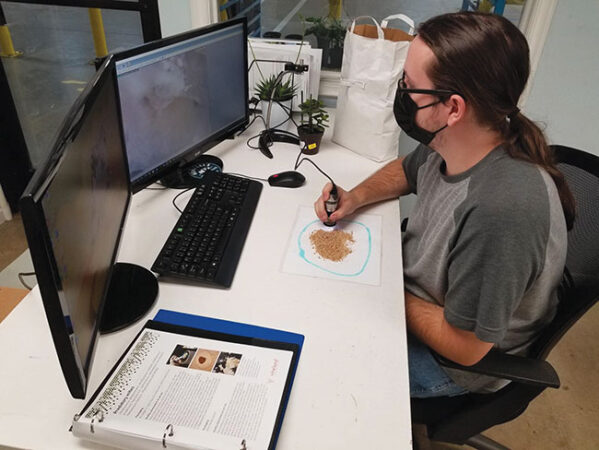
Features
Biocontrols
Inputs
Test and release: Grower quality assurance of biocontrol agents
Just before releasing your newly arrived bios, be sure to test for quality. Here’s why.
February 22, 2022 By Rose Buitenhuis, PhD
 A lot can happen between shipping and release into the crop. The best time to perform one last quality check is upon arrival and just before release.
Photo credit: R. Buitenhuis
A lot can happen between shipping and release into the crop. The best time to perform one last quality check is upon arrival and just before release.
Photo credit: R. Buitenhuis “If you see them crawling around, they should be fine.” This is a common response when people ask how they would know whether their biocontrols are okay.
While this observation can pass as a quick check, there’s much more you can do to test the quality of biocontrols. For instance, how many should you be seeing? Do they seem sluggish? Are they dead or just chilling? What does it mean if you see no movement at all?
Are your bios in top shape?
When your package of biocontrol agents leaves the insectary, a lot of work has gone into making sure it will arrive in top condition at your doorstep.
The biocontrol companies have strict rearing and quality assurance procedures. Packaging is optimised to keep the bios breathing and at the right temperature while using the fastest shipping options available.
Nevertheless, a lot can happen in the time between shipping and release into the crop.

While quality control testing on bios can become time-consuming if performed on a regular basis, it allows staff to become familiar with the various products and provides ways of investigating any issues that may arise.
Photo credit: R. Buitenhuis
Biocontrol agents are living organisms, sensitive to transport, storage conditions and duration. Any variations in these factors can lead to declined quality upon arrival, however, sometimes the reason is a mystery. This is why the ideal time to perform one last quality check is the moment when the biocontrol agents arrive at the greenhouse, just before they are released.
Once the bios are dispersed into the crop, the only signs of their presence will be the successful suppression of pests and occasional sightings of the predators and parasitoids themselves or their products, such as parasitized aphids or whiteflies. By then, it would be very late in the game to react to sub-optimal performance due to quality issues, and overall pest control may suffer.
Tools to check your bios
In 2014, we compiled the Grower Guide to Quality Assurance of Biocontrol Products in response to inquiries from greenhouse growers who wanted simple methods for checking the viability of biocontrol agents.
At that time, the only available guidelines were the ones published by the International Organization for Biological Control (IOBC). These IOBC protocols were intended for use by biocontrol supply companies in mass rearing, and because of that, were much too involved to be useful outside of a scientific laboratory.
To tailor the guidelines towards end users, we collected, tested and compiled methods that could be completed by staff at commercial greenhouses using minimal materials and a bit of crafting or DIY. Over time, we added a few new protocols including ones for predatory mite sachets. Each species has its own protocol, with details on steps to take for quality assessment at arrival based on the packaging, as well as signs of activity in the crop.
In addition to the guide which was updated in 2017, several videos demonstrate how to conduct the tests. The videos can be found on Youtube channels by Vineland Research & Innovation Centre as well as Greenhouse Canada, and include ones on nematodes and slow release sachets. Additional videos will be finalized in early 2022.
Note that pest control can still fail, even with high-quality biocontrol agents. In these cases, ask yourself the following:
- Are your expectations too high? Keywords for biocontrol are prevention and patience.
- Is there any interference from pesticides? Check the side-effects tables from the respective companies for compatibility and residual time.
- Did you release the right biocontrol agent for the pest? Make sure you properly identify the pest and match it with the right biocontrol agents.
- How did you release the bios? Timing and placement are important to set bios up for success.
A recorded webinar, available on GreenhouseIPM.org, provides more details and answers to these questions.
Feedback from industry
To learn more about the importance and impact of grower QC on biological use in commercial greenhouse operations, I spoke to IPM staff at three companies in Canada and the US about their experiences.
Boekestyn Greenhouses: Boekestyn Greenhouses, located in the Niagara region of Ontario, has been growing potted ornamental plants using biocontrol for many years. The growing team would regularly conduct simple visual and smell checks to see if their shipments of biocontrol agents were okay.
When the Grower Guide was initially published in 2014, they worked with IPM consultant Graeme Murphy to test several of the protocols and to provide feedback. They also wanted to compare different suppliers. In doing so, they discovered that conducting QC on all of the products on a weekly basis was very time consuming.

Boekestyn Greenhouses sieves out larger pieces of bran, leaving the smaller pieces and predatory mites at the bottom. They use this method to check for quality on most of the mites they receive in bulk and sachet form.
Photo credit : Boekestyn Greenhouses
On the other hand, through their tests, they also realized that predatory mites in bulk product tend to aggregate at one end of the package, which means it is important to mix the product well to get an even distribution.
Overall, they say the process helped them become more familiar with the products and that it was a great way to learn more about biological control.
Today, they still do quick checks of their bios on arrival to ensure everything looks normal. Only when something seems off, do they use more in-depth methods to investigate further.
Wholesum: Dr. Harumi Kuniyoshi is director of research and development at Wholesum, a large organic vegetable greenhouse in Arizona.
She and her team developed their own quality control methods to determine the viability of whitefly parasitoids from cards and predatory mite sachets. They wanted to demonstrate to the production side of the company that biocontrol was actually working. In addition, they wanted to compare products from different vendors.
From their tests, they found that quality could fluctuate significantly, including at different times of the year. Having reliable data enabled them to communicate their problems to suppliers, who then sent product replacement.
Harumi says conducting QC on a regular basis allows them to trace the source of the problem.
For example, they once detected an issue when a shipment of bios was stored under incorrect conditions. To compensate, they adjusted their biocontrol order for the next week. This helped them ensure that there were enough biocontrol agents to keep pests under control.
Harumi says she would like to perform quality checks on more products, but acknowledges that it is a time-consuming process.
Costa Farms: Michele Opela, IPM manager at Costa Farms in North Carolina, says they started a biocontrol program in their ornamentals production about three years ago.
They decided to perform quality checks on all of their biocontrol shipments when they ran into problems implementing their IPM program. They also wanted to determine which vendors and product formulations gave them the best results, adjusting their purchases accordingly.
Michele says they continue to check every product they receive.
Some products, including larger predators like lacewings, get a quick eyeball to see if they are alive and moving. Others, like aphid and whitefly parasitoids, are checked thoroughly using methods from the Grower Guide.

At Costa Farms, one of their scouts is spotted conducting a quick QC check on cucumeris.
photo credit: Costa Farms
This can take up to one full day if there is a lot of material to process, and checking predatory mite bulk product is especially time consuming. However, she says it is worth the effort. They identified a problem with a predatory mite product where they found fewer predators than stated on the package and consequently changed suppliers.
She says an added benefit to the quality checking process is that their IPM scouts are becoming more familiar with biocontrol agents, gaining a better understanding of their use and biology, and are building professional expertise.
Conclusions
Based on these discussions, it is clear that conducting QC on a weekly basis on all incoming biocontrol agents may be excessive, especially when given limited resources and time.
However, if a problem is suspected, the methods in the Grower Guide can provide IPM staff with standardized ways to investigate and, if necessary, communicate with suppliers. When regular QC is required, methods can be adapted or the focus can be narrowed to a few critical products.
While the protocols are designed to be simple, those interviewed for this article agreed it does take some practice. However, testing is a great way to become familiar with biocontrol agents and products.
Rose Buitenhuis, PhD, is the senior research scientist in biological control at Vineland Research and Innovation Centre. Have questions or feedback on the Grower Guide to Quality Assurance of Biocontrol Products? Contact Rose at rose.buitenhuis@vinelandresearch.com.
Print this page